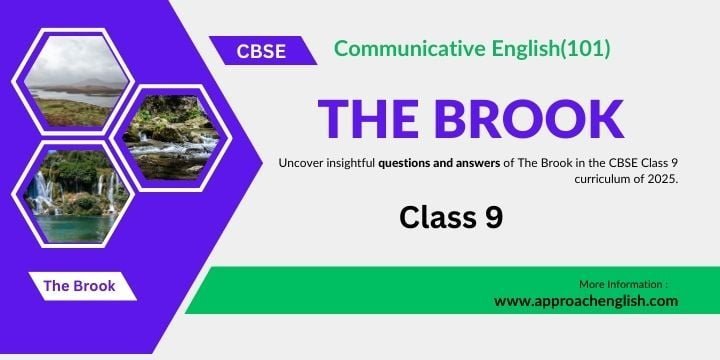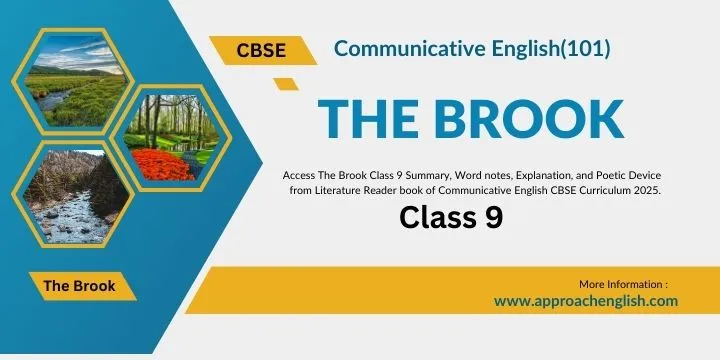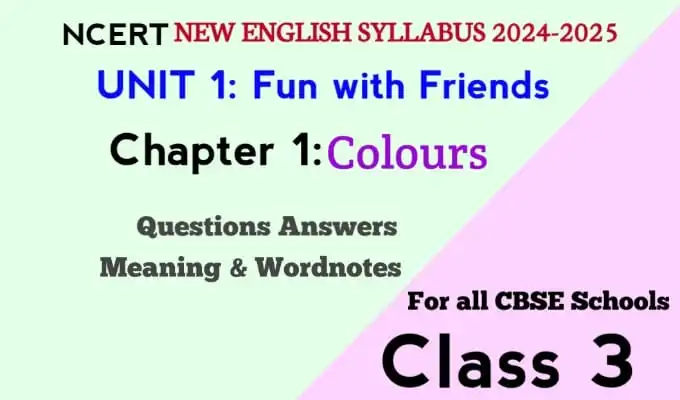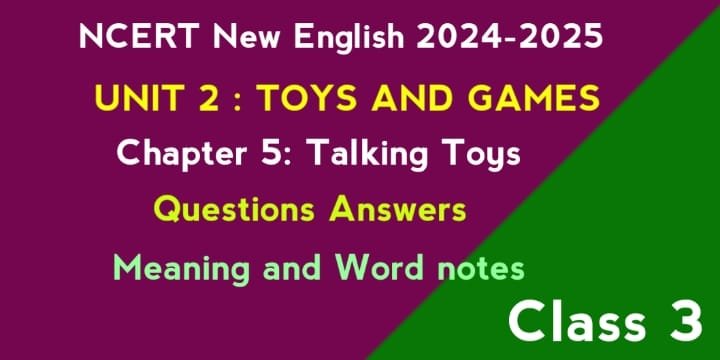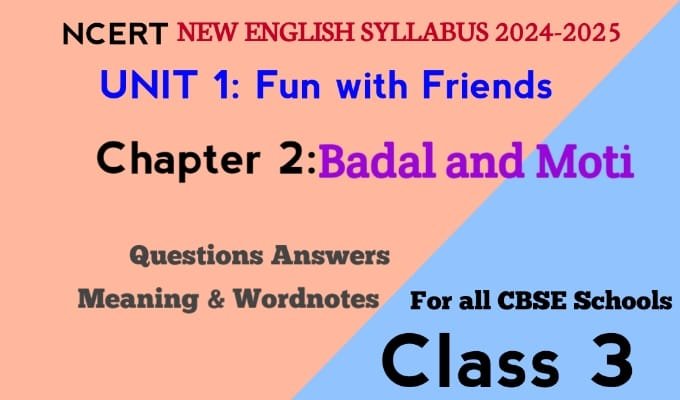Uncover insightful questions and answers of The Brook in the CBSE Class 9 curriculum of 2025. Gain a deeper understanding of this poem through comprehensive explanations and analysis, perfect for academic study and exam preparation.
Textual Questions and Answers of The Brook Class 9
These textual Questions and Answers are based on Communicative English: Literature Reader Page 66 onwards.
4. After reading the poem, answer the following questions.
The poet has used a number of words which indicate ‘movement’ and ‘sound’. Working with your partner make a list of these words from the poem and complete the web chart.
a. Movement Words:
move, sally, sparkle, slide, travel, wind, flow, slip, hurry.
b. Sound words
bicker, murmur, fret, bubble, chatter.
6. On the basis of your understanding of the poem, answer the following questions by ticking the correct choice.
(a) The message of the poem is that the life of a brook is ……
(i) temporary
(iii) eternal ✔
(ii) short-lived
(iv) momentary
(b) The poet draws a parallelism between the journey of the brook with
(i) the life of a man ✔
(ii) the death of man
(iv) the endless talking of human beings
(iii) the difficulties in a man’s life
People also ask
(c) In the poem, the below mentioned lines suggest that
“And here and there a lusty trout,
And here and there a grayling”
(i) the brook is a source of life ✔
(ii) people enjoy the brook
(iii) fishes survive because of water
(iv) the brook witnesses all kinds of scenes.
(d) Select the option that matches the given words/phrases with the appropriate literary device used by the poet.
| Words | Literary Device |
| (i) Chatter; Babble, Murmur | 1. Alliteration- the occurrence of the same letter or sound at the beginning of adjacent or closely connected words |
| (ii) Men may come and men maygo but I go on forever. | 2. Onomatopoeia-the formation of a word from a sound associated with what is named |
| (iii) fairly foreland; with willowseed; foamy flake; golden gravel | 3. Inversion reversal of the normal order of the words and phrases in a sentence |
| 4. Refrain a word, line or phrase that isrepeated within the lines or stanzas ofthe poem itself. |
(i) i-2, ii-1, iii-4 ✔
(ii) i-4, ii-2, iii-3
(iii) I-2, ii-4, iii-1
(iv) i-1, ii-2, iii-3
(e) The first-person narration of the brook allows the reader to
(i) appreciate Tennyson’s use of symbols.
(ii) realize the ultimate goal of the brook..
(ii) experience the soothing effect of the sound of water.
(iv) understand the brook’s experience as a living organism ✔
6.B Read the given extracts and answer the questions that follow by selecting the correct options.
A. With many a curve my banks I fret
By many a field and fallow,
And many a fairy foreland set
With willow-weed and mallow.
(i) Choose the option that best describes the brook’s journey in the given stanza.
It is a journey full of
(a) comfort and luxury
(b) trials and tribulations✔
(e) sorrow and misery
(d) joy and laughter
(ii) The poet has used the pronoun ‘I’ to refer to the brook and thus employed a literary device in his depiction. Choose the option that uses the same literary device as used in the first line.
a) The magnitude of the bottomless ocean was divine.
b) The angry walls echoed his fury.
c) A mother is like a lioness protecting her cubs.
d) I felt the power of the gushing stream. ✔
(iii) The brook seems to be fretting in the given stanza. This word has been used by the poet to depict the ________ of the flowing brook.
a) force ✔
b) kindness
c) silence
d) beauty
B. I linger by my shingly bars;
I loiter round my cresses;
And out again I curve and flow
To join the brimming river,
For men may come and men may go,
But I go on forever.
(i) Choose the option that includes words that best describe the characteristics of the brook, as revealed in the given extract.
1. perpetual
3. twisted
2. silent
4. unbound
5. interrupted
(a) 1, 3 and 4
(b) 1, 2, 4 and 5
(c) 1, 2, and 3 ✔
(d) 1, 2 and 4
(ii) The line, ‘men may come and men may go’
(a) mocks the shortness of the brook’s life as it goes through its journey.
(b) highlights the eternal nature of human life as opposed to its own.
(c) contrasts the eternal nature of brook against short-lived human life-span ✔
(d) highlights the eternal story of men that the brook comes across during its journey.
(iii) What do the words, ‘linger and loiter’ show about the brook?
(a) Its continuity
(b) Its slow movement ✔
(c) Its powerful force
(d) Its ultimate purpose
7. Answer the following questions:
(a) How does the brook ‘sparkle’?
Ans: The brook’s water ‘sparkles’ in the sunlight when it flows out from its place of birth. The idea of ‘sparkling’ is transferred to the brook in a personified manner.
(b) ‘Bicker’ means ‘to quarrel’. Why does the poet use this word here?
Ans: The poet uses this word (bicker) to give out the idea of noise born out of ‘quarrels. It is also like the first ‘cry’ of a baby when it is born. The brook makes a lot of noise when it flows down. So in its making a lot of noise it seems to be ‘quarrelling’.
(c) Why has the word ‘chatter’ been repeated in the poem ?
Ans: The word ‘chatter’ has been repeated in the poem. It is to denote the idea of ‘talking’ when the brook flows over stony ways. Its murmuring sound over these paths is similar to its ‘chattering’.
(d) ‘I wind about, and in and out.’ What kind of a picture does this line create in your mind?
Ans: The picture created is of the current of water flowing in a zig-zag manner.
(e) What does the poet want to convey by using the words ‘steal’ and ‘slide’?
Ans: The poet wants to convey the idea of the brook’s silently passing by some hurdle. Also it slips by some obstruction which comes in its flow. This obstruction may be wild growth, a tree, a stony part or a sandy bank. Such things are generally found on the banks of a rivulet.
(f) I make the netted sunbeam dance.’ What does ‘the netted sunbeam’ mean? How does it dance?
Ans: The netted sunbeam’ means the sunbeam which falls on the brook’s bottom. It is trapped in its water. It then gleams and seems dancing when the water flows.
(g) What is a ‘refrain’ in a poem? What effect does it create?
Ans: The ‘refrain’ in the poem is ‘For men may come and men may go, / But I go on for ever. It creates an effect of permanence of the brook and the temporary aspect of human life. Secondly, it completes one single idea of the poem.
(h) Why has the poet used the word ‘brimming’ in the line, ‘to join the brimming river?
Ans: The poet uses the word ‘brimming’ to show the largeness, power, force and continuity. The brook is small, yet it has the capacity to be a mighty river.
9. Identify the rhyme scheme of the poem, The Brook.
Ans: The rhyme scheme of the poem is ab, ab.
10. The poem is full of images that come alive through skilful use of words. Describe any two images that appeal to you the most, quoting the lines from the poem.
Ans: I like the following two images:
One image is of the zig-zag movement of the water. It moves carrying on its surface many blossoms or leaves. Its water is transparent. One can see ‘trout’ and ‘grayling’ fish gliding at its bottom boob Wabup of an
The second image is of the brook flowing in thorny wildernesses. It is the night time. The moon and stars shine. The brook is flowing very slowly over its ‘shingly bars’. It loiters round’ its ‘cresses’ because these are pungent. i bro,todn bala
11. The brook appears to be a symbol for life. Pick out examples of parallelism between human life and the brook from the poem.
Ans: The examples of parallelism are:
(a) The brook makes ‘noise’ the moment it comes out of its source. It is like the ‘first cry’ of the baby when it is born. In youth one is young, strong and full of enthusiasm. Similarly, the brook in its ‘youth’ hurries down like a dashing young man. Similarly, it ‘sallies’, ‘bickers’ and ‘chatters’ like the young. All these words denote youthfulness.
(b) Human beings are a source of support and help for others. They are preservers in that way. The brook has ‘trout’ and ‘grayling’. It gives life to them or supports them. So both are similar.
(c) Men in old age become wise. They shed anger and don’t pick up quarrels. Similarly, the brook assumes this ‘peaceful demeanour’ when it steals by lawns and grassy plots’. It also does so when it slides ‘by hazel covers’. In other words, it makes its path by their side, instead of striking against these. Wise men always do escape such things of obstruction. They don’t easily involve themselves into useless quarrels.
EXTRACT Based Questions and Answers of The Brook Class 9
Read the extracts given below and answer the following questions:
Q. 1. ‘I come from haunts of coot and hern;
I make a sudden sally
And sparkle out among the fern,
To bicker down a valley’.
(a) Who comes from the haunts of coot and hern?
(b) What does it do among the fern?
(c) Why does the word, ‘bicker’ mean here?
(d) Explain: ‘I make a sudden sally’.
(e) How does the brook sparkle?
(f) Name a poetic device used in the above lines.
Ans: (a) The brook
(b) It shines.
(c) Rush quickly
(d) It means that the brook emerges suddenly.
(e) The brook reflects the sunlight and sparkles.
(f) Alliteration/Personification.
Q. 2. “Till last by Philip’s farm I flow
To join the brimming river,
For men may come and men may go,
But I go on forever.”
(a) Where is Philip’s farm situated?
(b) What does the phrase brimming river mean?
(c) Which poetic device is used here?
Ans: (a) Philip’s farm is situated close to the river into which the brook finally merges.
(b) The river is full to the brim; it is overflowing with water.
(c) Personification/Refrain.
Q. 3. “I chatter over stony ways,
In little sharps and trebles,
I bubble into eddying bays,
I babble on the pebbles.”
(a) How does the brook move?
(b) What is the mood of the brook as it flows towards the river?
(c) What poetic device has been used in the last two lines?
Ans: (a) The brook moves in a swift current with tremendous noise.
(b) The brook is in a joyous mood. It seems to be talking and looking forward to joining the river.
(c) Alliteration.
Q. 4. “I chatter, chatter, as I flow
To join the brimming river,
For men may come and men may go,
But I go on forever.”
(a) What is the rhyme scheme of the above stanza?
(b) Name the poetic device used in the first line.
(c) Explain the meaning of the third and fourth lines.
Ans: (a) abab.
(b) Onomatopoeia/Personification.
(c) It means that man is mortal but the objects of nature are immortal.
Q. 5. “I wind about, and in and out,
With here a blossom raining,
And here and there a lusty trout,
And here and there a grayling.”
(a) Name the poem from which the above stanza has been taken.
(b) What has been described in the above lines?
(c) What does ‘trout and ‘grayling’ refer to?
Ans: (a) The Brook.
(b) The life of the brook.
(c) Trout and grayling refer to different kinds of
Q. 6. “I slip, I slide, I gloom, I glance,
Among my skimming swallows;
I make the netted sunbeam dance
Against my sandy shallows.”
(a) Name the literary device used in this stanza.
(b) Why did the swallows touch the surface of the brook?
(c) What do ‘slipping’, ‘sliding’, ‘glooming’ and ‘glancing’ reflect?
Ans:
(a) Alliteration.
(b) The swallows touch the surface of the brook to catch the fish.
(c) All these words reflect the various moods and movements of the brook.
Q. 7. “I murmur under moon and stars;
In brambly wilderness;
I linger by my shingly bars;
I loiter round my cresses.’
(a) Who is ‘I’ here?
(b) What does the word ‘linger’ indicate?
(c) When does ‘I’ murmur?
Ans:
(a) The Brook.
(b) The word ‘linger’ indicates slow and soft movement.
(c) The brook murmurs while passing through brambly wilderness under the moon and stars.
Q. 8. I come from haunts of coot and hern*;
I make a sudden sally
And sparkle out among the fern,
To bicker down a valley. (CBSE 2014)
(a) Who is “I” in these lines?
(b) What is this figure of speech known as ?
(c) Why does it bicker down a valley?
Answers
(a) T’ in these lines is the brook.
(b) This figure of speech is known as ‘personification’. child to e
(c) ‘It’ bickers down a valley because it falls from some height. In doing so, it creates a lot of noise.
Secondly, ‘it’ bickers like a newborn baby as it, too, like the baby, has taken birth just now. A newlyborn baby cries at first instant.
Q. 9. I chatter over stony ways,
In little sharps and trebles,
I bubble into eddying bays,
I babble on the pebbles. (CBSE 2012) (CBSE 2015)
(a) How does the brook ‘chatter’?
(b) Which stage of the human life is presented here?
(c) Which word means ‘high-pitched’?
Answers
(a) The book ‘chatters’, that is, makes a noise while flowing over stony ways.
(b) It is the youth, that is the stage of human life, that is represented here.
(c) ‘sharps and trebles’.
Q. 10. I wind about, and in and out,
With here a blossom sailing,
And here and there a lusty trout,
And here and there a grayling. (CBSE 2012)
(a) Name the poem from which the above stanza has been taken.
(b) What has been described in the above lines?
(c) Give the meaning of ‘trout’ and ‘grayling’.
Answers
(a) It is “The Brook’ written by Lord Tennyson.
(b) The movement of the brook with fish has been described in these lines.
(c) These are various kinds of fish.
Q. 11. And draw them all along, and flow
To join the brimming river
For men may come and men may go,
But I go on for ever. (CBSE 2015)
(a) What does the brook draw along with it?
(b) Where is the brook going?
(c) Which poetic device is used in last two lines?
Answers
(a) The brook draws along with it all the gravels and foams.
(b) It is going to join the brimming river.
(c) It is ‘alliteration’.
Short Question and Answers of The Brook Class 9
Q. 1. Describe the birth of the brook. How does it flow after the birth?
Ans: The brook takes its birth from a place which is visited by various water birds. These water birds are ‘coot and hern’. After taking its birth it sparkles out among the vegetation. Then it flows noisily down the valley.
Q. 2. What comes on the way of the brook? What is its destination? (K.V. 2015)
Ans: The brook hurries down the hills. It slips between the ridges with a flowing noise. Villages, towns and bridges come on its way. After passing by these villages and bridges, it joins the brimming river.
Q. 3. Why is the brook so enthusiastic to join the brimming river? (CBSE 2012)
Ans: The brook is very enthusiastic to join the brimming river as it has to in any case. The brook here is not simply a small river. But it is something of the divine things, say like a soul and the nature and ocean as the universe. Both merge together; so does the brook in its merging with the river.
Q.4. What are the different stages in the journey of the brook? How is a brook’s journey similar to a human being’s life? (K.V. 2015)
Ans: The different stages in the journey of the brook are taking birth, growing, youth and maturity. This journey of the brook is similar to a human being’s life. The brook takes birth and babbles noisily in flowing. When it flows over pebbles, it shows its anger like a young man. It grows silent before joining the brimming river.
Q. 5. How does the brook behave like a human being?
Ans: The brook behaves like a human being while flowing. It gets angry in flowing in curves by its banks. It creates noises in flowing by fields and uncultivated lands and flows angrily by land edges that extend into it. Chattering, it joins the brimming river.
Q. 6. What are the two ways in which the Brook is similar to life? (CBSE Sample Paper)
Ans: There are many ways in which the brook is just similar to human life. After birth,it makes a noise in sallying out like a born baby. It bickers and chatters, babbles and bubbles when it flows over stony ways. Human beings do so when they face hurdles. It merges with the big river like humans merge with the universe after death.
Q. 7. What are the different things that can be found floating in the brook? (CBSE 2012)
Ans: There are various things that can be found floating in the brook. There are various kinds of fish like ‘trout’ and ‘grayling. Then there are various leaves of the plants and trees that grow on the banks of the brook. The water flows with them.
Q. 8. How does the brook flow by lawns, plots etc? (V. Imp.)
Ans: The brook passes silently by lawns and grassy plots. It slides by small trees or bushes growing nuts. It moves the sweet forget-me-not flowers which grow near it or on its banks for happy lovers.
Q. 9. How does the brook create ‘music’ in its flow?
Ans: The brook creates ‘music’ in flowing by various things that come in its way. It slips and slides. It glooms and glances with sadness among the swallows. They skim over its water surface for food. The netted sunbeams dance against its sandy shallows.
Q10. What is the refrain given in the poem? What does it symbolise?
Ans: The refrain given in the poem is both meaningful, philosophical and musical. It is that men may be born and die but it goes on for ever. In this refrain, the poet is creating music. But he is also symbolising through the brook the basic truths of life. It is men are mortal but the brook is immortal.
Long Answers and Questions of The Brook Class 9
Q. 1. How does the brook flow? What does it carry in its flow? (V. Imp.)
Ans: The brook flows like a musical instrument. It creates its own ‘music’. This ‘music’ is clear from the onomatopoeic words used by the poet. The brook ‘chatters’, ‘frets’, ‘slips’, ‘slides’, ‘murmurs’ and ‘lingers’ along on its way.
It changes its flow and sound in relation to the presence of different objects on its way. It carries many things in its flow. Many blossoms, lusty trout, grayling or foamy flakes swim and flow in its water. It draws these above the golden gravel. Its bed shines like golden things in the sunshine. It travels on its journey to join the brimming river.
Q.2. Answer the following in about 150 words. The brook comes across many hurdles in the course of its journey. Compare its journey with man’s life. (CBSE 2012)
Or
Compare the journey of the brook to the life journey of man. (K.V. 2015)
Ans: After taking birth, the brook faces many hurdles like man. It emerges suddenly and flows down the valley speedily. The brook makes strange noises when it flows over stony paths and it passes through valleys, towns and under the bridges. It goes through wildernesses silently. Its banks are curvy. Then its flow becomes less forceful. Through wildernesses, it flows peacefully as if it faces many hurdles. The ‘hurdles’ are wild growth, a tree, a stony path or a sandy bank. At some places, it disappears underground and then re-emerges on the surface.
Its journey is compared with man’s life. It makes noises like the young people. It supports life in the form of fish like human beings support other forms of life. In old age, humans become mature, silent and wise. They show these in their behaviour. Likewise, the brook shows these in its silence. Then it merges with the brimming river as human beings merge with the universe in their death.
Q. 3. You are Tennyson. Write a letter in approximately 150 words to your friend describing the journey of the brook. (CBSE 2012)
Ans:
23 September, 20xx
My dear Tom,
I hope you are well. In this letter I am describing the effect of my poem “The Brook’ that I have composed. The brook’s journey is equated with man’s life. The journey is very interesting from the brook’s birth and death when it merges with the river. So the poem has a double meaning. The brook takes birth at a place which is visited by various birds like ‘coot and hern’. It emerges suddenly and flows down the valley and flows on stony paths and among wildernesses.
The brook takes various things in its current. These are trout and grayling, forget-me-not flowers etc. At some places, it goes unseen, then it re-emerges. At certain places it rushes but at other places it flows very peacefully and noiselessly. Various plants, trees and other vegetation grow on its banks. The sun-beams dance over its surface. Various birds fly over its watery surface. Finally, it flows to join the brimming river.
Yours sincerely
Tennyson
Q. 4. As a reader of ‘The Brook’ you feel the music created by the words used in it. You write a diary page appreciating the musical side of the poem. Write that diary page about this music created by the words. (CBSE Sample Paper)
Ans:
10 pm, Monday, 12 December, 20xx
Today I read Lord Alfred Tennyson’s poem “The Brook’ and was overwhelmed by the music created by the words. I would say that the poet has used various poetical devices like alliteration, assonance, inner and outer rhyme to create a beautiful beat in music. This has also been possible in his use of certain onomatopoeic words like ‘slip, slide, ‘gloom’, glance’ and ‘chatter’, ‘bubble’, ‘babble’, ‘pebbles’, etc. These words actually denote ‘movement’ and ‘sound’.
The rhyming scheme in each stanza follows ab, ab pattern. Then inner rhyming sounds like /f/ in ‘a fairy foreland’ and ‘I mind about, and in and out’ adds melody to it. The refrain in ‘men may come and men may go/But I go on for ever’ creates a magical kind of music that gets in the blood of the reader. By using various words the poet has created a kind of sensory effect on the senses. When we read the poem, we feel this music on our senses. We also feel delighted as if we were listening to a melodious song. Thus the poem leaves a permanent impression on our senses through various words of movement and sound.
Q. 5 . “The Brook draws many things along with it, immaterial of what they are.” How does this statement hold true for Man’s life as well? Discuss the values that man draws from the brook’s journey of life. (80-100 words) (CBSE 2014)
Answer
“The Brook” is just another name of life. It runs parallel to human life and symbolizes every aspect, from birth to death. As man goes through happy, unhappy, good, bad experiences and ups and downs in life, so does the brook in a beautiful manner. It doesn’t care what hurdles it faces before losing its identity in merging with the ocean. Similarly man goes on living life with its good, bad, hot, cold, joys, sorrows, happy, unhappy moments. He carries all these facets of life with him like the brook does.
Thus we draw the values of struggles, determination, readiness to fight the obstacles, perseverance, endurance, strong will to survive amidst all obstacles, from the brook. The brook is like a road roller for all the obstacles. So is man. By these above values, man takes everything with him in the journey of life as does the brook take all things with it.
Q.6. The Brook is a symbol of energy and determination to us. Describe in about 150 words. (Board Term 1 2012)
Ans: The poem draws a parallel between the journey of the brook and the journey of human life. Similar to the journey of the brook, human life also passes through many ups and downs. The brook passes through many hills, ridges, towns, villages and bridges and reveals its mood by the sound it makes when it moves on. Similarly, man also has to hurdles and difficulties in life and overcome many has to struggle hard to reach his destination. Nei- ther the life of man nor the journey of the brook is smooth. But, just as the brook goes on undaunted and heads towards its destination, human beings must also go on.
Q. 7. Like human beings, brook also has different stages of life. Describe its various stages with suitable examples from the poem ‘The Brook. (Board Term I, 2010)
Ans: The brook goes through different stages of life as does a human being. In the way a child takes birth, the brook emerges from the haunts of the coot and
hern. Just like a child, the brook chatters and babbles. It is as energetic as a human being in the initial stages of its life. As human beings work to fulfill their aim in life, the brook’s aim is to join the brimming river. Man faces a lot of challenges in life, likewise, the brook takes many twists and turns during
its second course. In the third course, the brook slows down and slips, slides, and steals by the lawns and grassy plots. In the same way, in old age, man becomes quiet and understanding.

